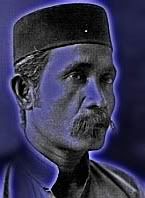Cannon Fire, Bell And Drums
In Sumatra, the practice passed down for generations was that boys never slept at home, preferring the camaraderie and the life of instruction in the local surau or langgar that were not really mosques but just the village prayer house. It was an arrangement that shaped the early life of Hamka (Haji Abdul Malik Karim Amrullah), a writer who was loved both here and there. So his early life in Sumatra went thus:
"In the month of Ramadhan, the boys broke fast in the surau with the elders. The adults did the the tarawih prayer in a group, then the children sat in a circle for the tadarrus i.e. the reading of the Qur'an, each reciting a portion. We stayed up till 1 a.m. returning home to awake our mothers and grandmothers to prepare the early morning meal (before the fast). While waiting for the rice to cook we snatched a moment of sleep, and were not awoken until the meal was all ready and laid out. We ate while still half asleep. Sometimes, as soon as we finished eating there were already voices in the front yard calling us out to the surau again."In Kuala Trengganu our house was cheek by jowl with our local surau Sheikh Abdul Kadir that called out the prayer times by drum and voice. The drum of cow hide, or geduk as we called it in Trengganuspeak, was beaten to a rhythm that started in quick short bursts, then lingered at peak in four or five well-thumped, well-spaced out beats, then dropping again in short bursts that soon faded out. Each burst that reverberated to our rafters, also shook the crockery in our house; once bringing down a trayful of agar-agar that mother had put out to dry in the sun.
in Kuala Trengganu people slept in our suaru during or outside the fasting month, but they were not local boys but mostly old folk who could not be bothered to go home, or fishmongers' assistants and urchins who saw more of the streets than the inside of a house. When the oldies awoke with the reddening of the sky by the shuffling of the muezzin preparing for his early morning call, the fish tenders continued their dreams of the deep while the urchins merely stirred beneath their sheets of flimsy batik and rolled back to sleep on their other side. This was in the wide verandah in the back of the surau; past them the muezzin walked, past the bundles of human shapes, then on cue he raised the hitter of the geduk.
In Ramadhan, if anyone was minded to make the short walk to the suaru there was an additional hitting of the geduk just before dawn painted the sky red with its brush. This marked the end of the sahur, when plates were collected by ladies of the house and late eaters took their last gulp of the coffee down to the residues at the bottom of the glass, and when everyone who was up resisted sleep to await the dawn prayer of subuh. It went well until one morning an elderly neighbour woke up in a stupor and made straight for the geduk. Needless to say it sent everyone reeling in panic; and when I looked out of our window I saw him standing by the geduk scratching his head, trying to explain his erratic beats to another neighbour who came rushing out from his house.
In addition to the geduks that sounded out their beats in local suraus and madrasahs Ramadhan was a time in Kuala Trengganu for cannon blasts from distant hills that marked out the times for the beginning and ending of the fast, and when the wind was blowing right we'd hear the pealing genta from the beacon hill of Bukit Putri that was perhaps a quarter of a mile from our house. The genta was the Trengganu bell, cast in the ground of the Istana Maziah at the foot of the hill and then taken to the hilltop to ring out good news and sad. My memory of it was just of the Hari Raya ('Eid Days) and the constant ringing out to mark out the times in Ramadhan from when the sun began to set.
Not a hundred years before that — I am told — the genta pealed out not just for joy but also at times when an amok was at large, when people in the streets would be scrambling to the genta sound, for somewhere safe from whoever it was on the rampage.
Above extract translated from 'Renungan Tasauf' ('Reflections on Sufism') by Hamka, Penerbit Pustaka, Panjimas, Jakarta, 1995.

